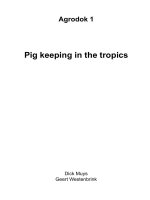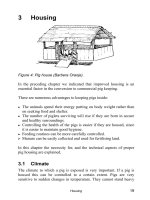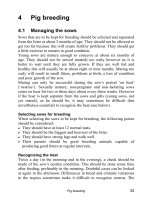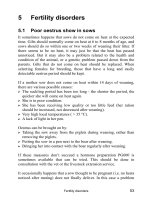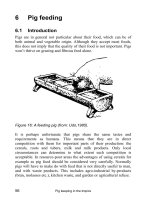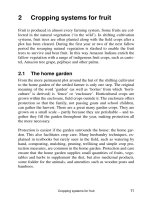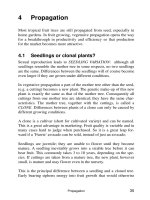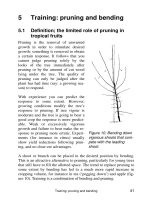Goat keeping in the tropics - Part 3 ppsx
Bạn đang xem bản rút gọn của tài liệu. Xem và tải ngay bản đầy đủ của tài liệu tại đây (142.69 KB, 10 trang )
Goat keeping in the tropics
18
3 Raising and selection
By “raising”, we mean taking care of the newborn kids until they are
sexually mature. The better the care, the greater the number of animals
of good quality which will reach maturity.
3.1 Raising new born kids
Milk is the first food of the kid. The gastro-intestinal tract of the
young goat is geared to properly digesting this energy- and protein-
rich food. The first milk of the mother animal, the colostrum, is ini-
tially very concentrated, but 24 hours after the birth the milk already
closely resembles that which is produced during the rest of the lacta-
tion. Apart from nutrients the colostrum contains antibodies which are
not yet broken down in the digestive tract of the newborn kid; they are
therefore absorbed as a whole through the wall of the intestine by the
blood. These antibodies provide protection against certain bacteria.
However, the digestive tract quickly changes and all protein is then
broken down, including the antibodies. It is therefore important that
the newly born animals drink the colostrum as soon as possible after
birth, often and a lot. This will be no problem as the kids will find the
teats themselves.
Young mother animals, or animals in poor health, sometimes have dif-
ficulty accepting their young. You can then either hold the mother still
so that the young can drink, or place the young with a mother who
will accept them. If the latter has also just given birth, rubbing the
“orphan” in with her afterbirth can help with acceptance (scent recog-
nition).
It is important to carefully observe the kids. You will see that one kid
is much more active than the others, or grows faster. If a kid stands
somewhat listlessly alone, with raised hairs on an arched back, staring
straight ahead, then it has not had any milk that day. Avoid letting this
go unobserved: know your kids.
Raising and selection
19
Supplementary feeding
For manual (supplementary) feeding, goat’s milk is best. Should no
goat’s milk be available, for whatever reason, give other kinds of milk.
Cow’s milk (if necessary made from milk-powder) is an obvious
choice; you will have to give it to the kid yourself using a baby bottle
or a bowl. Playing with the kid’s tail, or offering it a finger to suckle,
stimulates it to drink. It is also very important that the milk is at the
right temperature, 40 °C. All this is no easy task but can be learned.
Cleaning the bowl or bottle very thoroughly is extremely important! Harmful
bacteria quickly multiply in leftover milk and cause diarrhoea.
Fresh roughage
From several days after the birth on, the kids must have access to daily
fresh roughage: grass, herbs, hay, etc. In the beginning the kids will
only nibble at this food, nevertheless it is important. With this food, a
kid takes in useful bacteria which ensure that the digestive tract be-
comes adapted to the digestion of roughage.
3.2 Weaning the young
After three months a young goat can in principle live entirely off high
quality roughage, and could be separated from its mother: this is the
so-called weaning. The young are then no longer allowed to stay with
the goat so that they can no longer drink from their mother.
Clean drinking water must be available in the weaning period.
Early weaning is important when keeping milking goats as the milk is
then available earlier for your own consumption and sale. If the rapid
growth of the young goats is more important because of meat produc-
tion, you can leave them a little longer with the mother goat. Do re-
member to wean the young goats at least two months before the next
gestation period of the mother.
Goat keeping in the tropics
20
3.3 Caring for the young animals
Young animals need high quality feed to continue to grow well. The
best grazing areas should first be for them, in some cases together
with their mothers. They can then select the best parts of the plants,
and there is less risk they will get a serious worm infection than if they
graze with the herd. You can also separately give the animals extra,
high quality feed (see Chapter 4 on Nutrition).
3.4 Selection
The reason for selecting animals is maintaining or improving the
properties of a group of goats. The relevant properties for production
are: reproduction, growth (meat production) and/or milk production.
A goat doing well for all properties does not exist. The goat keeper
tries to get goats which are most suited to local circumstances and re-
quirements. To achieve this, goat keepers select goats with desirable
properties from the herd and use those goats for breeding. Otherwise
you can buy animals from outside, in order to improve the properties
of the herd.
Environmental factors
The properties of a goat are not only determined by its genetic charac-
teristics but also by the possibilities to manifest this characteristic. The
extent to which it is possible to do so is determined most by the envi-
ronmental factors, such as climate, feed (quality and availability), hy-
giene, housing and general care. It is pointless to start selecting ani-
mals if you do not first ensure optimal environmental conditions. By
doing so, you will have more rapid results than by selecting for
hereditary properties.
Animal factors
Apart form the environmental factors, animal factors also influence
the properties of a goat. Animal factors are: the age, the sex, being in
heat or not, carrying young or giving milk, first time bearing young or
having had more litters, etcetera. During selection, it is necessary to
Raising and selection
21
compare those animals which live under the same conditions and
which have the same set of “animal factors”.
Selection procedure
Compare the results of the goats within the group, and compare them
with those of the neighbours (which keep the same kind of goats under
similar circumstances). The more animals you have, the more difficult
it is to weigh all the different factors and make a good choice. An im-
portant aid in doing so is a good administration of the data of each
animal. For this, see Chapter 8 Administration.
Before discussing the selection process any further, we must point out
never to select for one specific property only, without considering the
other characteristics of a goat. This can have negative consequences.
The main selection goals:
? improvement of reproduction;
? improvement of milk yield;
? improvement of meat production (growth)
In the following sections the selection procedures for each selection
goal are described. You should treat the selection procedure seriously
and carefully because you gain easily by making a good start with a
strong goat that will live long and that will be a good producer for a
long period of time.
Before a selection for the specific production goals a first selection
almost happens unnoticed: selection by judging the exterior of the
goat.
3.5 Judging the exterior
When judging the exterior it is good to systematically make use of
fixed criteria.
? Look for good legs.
? A deep and wide chest gives more room for the organs and indicates
that they are well developed. The animal can also eat more and
therefore produce more.
Goat keeping in the tropics
22
? Look for a good and proportional general development, a shiny at,
well-placed and developed sexual organs.
? With a (milking) goat, you should look for a well-placed (between
the hind legs) and developed udder, strongly veined with good large
teats which point straight down.
Measurements
To objectively determine the proportions of the body, it is good to take
some measurements. A goat with a good-looking colour pattern which
is nice and calm, is unconsciously valued more. Some measures are
the shoulder height, circumference of the chest just behind the fore-
legs and the length of the back. This last measure is the distance be-
tween the highest point of the shoulder blade and the hipbone.
Figure 5: Judging the exterieur
Judging the age of an unknown goat
When judging an unknown goat, it is useful to also be able to estimate
its age. This can be done by checking the teeth: The teeth give an indi-
cation of the age of the animal and without good teeth a goat can not
eat as much. Goats have 4 pairs of teeth. Up to one year of age, a goat
has only small milk teeth, which are changed in the years following.
The age of an animal can be determined by looking at the number of
teeth the goat has changed and, in older animals, to what extent they
are worn down.
Raising and selection
23
At 1½ year: 1 pair has changed UUUU UUUU
At 2 years: 2 pairs have changed
UUUU UUUU
At 2½ years: 3 pairs have changed
UUUU UUUU
At 3½ years: all 4 pairs have changed UUUU UUUU
After the teeth have changed, they start wearing down. The extent of
wear is an indication of the age of the animal. It also depends on the
kind of feed.
3.6 Selection for reproduction
Selection for reproduction properties is important for every goat
keeper. The things you must look at are the servicing results:
? how often does each goat give birth per year (time between litters)
? how many kids does are born per litter
? How many kids die and how many survive
Together this gives you:
the number of successfully weaned kids per goat per year.
Keeping reproduction records
By carefully recording the above mentioned data, you can evaluate the
results of each individual goat. Your ability to judge your goats im-
proves with the amount of data available per goat. It is best to follow
the goats for two years, for example, before you draw definite conclu-
sions. Goats which are judged not to produce well are replaced as
quickly as possible. See Chapter 8 - Keeping records.
Putting the selection into practice
Goats of which the number of successfully weaned kids per year is
disappointing without any clear reason, are replaced.
There are two ways of getting replacements:
? buy good goats from a reliable address (judge them on the exterior
and possibly ask about their history);
? keep young from your own very best goats.
Goat keeping in the tropics
24
If the overall number of kids born per goat for the whole herd is low,
and it cannot be due to poor conditions on the farm, then the billy
goat(s) could be the cause. Try borrowing a good billy goat from a
neighbour and see if the results improve.
Regularly replace the billy goat(s) with new billy goats to avoid in-
breeding (once a year). Buy these billy goats preferably from other
breeders of whom you know that in their selection they pay attention
to those factors which are important for you.
3.7 Selection for milk production
This selection is done if you keep goats for milk production. As men-
tioned before, milk production is influenced by different factors. You
must pay attention to optimising the environmental factors for milk
production which you can influence. They are: feed, housing, hygiene
and care.
Keeping records of milk production
To be able to evaluate the milk production of the goats, it is necessary
to make daily notes on the milk yield per goat. This must be done con-
sistently, otherwise the data will be of little value.
Milk production will vary over the lactation period. Normally at the
start of the lactation the amount of milk per day increases rapidly.
Subsequently the milk yield reaches a maximum after about 1 month
after giving birth. The period during which the daily milk yield is high
lasts about two months, after which it declines again. It then continues
at a lower level for some three months.
The stimulation of the udder by milking or by suckling kids makes the
lactation period last longer.
In tropical climates, milk yields of one to two liters of milk per day
can be attained on a diet of forage.
Raising and selection
25
Putting the selection into practice
In the selection, the first thing to look at is the total milk yield in the 7
months after giving birth. Compare the total milk yield of your goats
and of those of other goat keepers.
You can try to improve the total milk yield by raising the peak produc-
tion. This you can do by improving the nutrition or other environ-
mental factors.
Keep the goats that produce well and use their young to replace lesser
goats.
Note: of course you must also keep continue to look at the reproduc-
tive properties of the goats.
3.8 Selection for meat production
When you select goats for meat production you have to know if you or
your clients prefer lean meat or fatty meat. Putting on meat takes place
especially in young animals; putting on fat, on the other hand, takes
place after the increase in flesh.
If fat meat is most desired, the animals are sold or slaughtered at older
age, or else you can deliberately fatten the young animals.
Putting the selection into practice
Weigh all the young animals at the same age, for example at three
months and at six months of age. This gives you information about the
growth of each animal.
Growth can be judged in two ways:
? How rapid is the growth of the animal;
? What is the maximum weight reached (for example when they are
one and half years old).
If the availability of feed is the limiting factor, you select the rapidly
growing animals. A mistake which is often made, however, is that
people sell or slaughter these most rapidly growing animals, when in
Goat keeping in the tropics
26
fact you must first select your future breeding animals from this very
group.
If feed is not the limiting factor, it can be more productive to select for
maximum weight achieved. Animals which grow quickest in the be-
ginning are not necessarily those animals which reach the greatest end
weight.
Selection for fatty meat
If the objective is to get fatty animals, in the first place it will be effec-
tive to fatten young animals by giving an excess of energy-rich feed.
The amount of fat which has been put on can best be judged from
slaughtered animals rather than from living ones. Therefore reserve
the sister or brother of the animals with good results for breeding.
Castration of young billy goats
Sometimes goat keepers prefer to castrate the young billy goats which
are not allowed to reproduce and which are bred for meat production.
It is not necessary to castrate them and there is always a risk that cas-
tration might cause infection and cause the animal to be ill. If you still
want to castrate young billy goats do this before they are three months
old. It is advisable to castrate them as young as possible; the shock is
then minimal. Many goat keepers prefer to castrate their billy-goats
when they are 2 or 3 days old. At this age castration is a small, quick
and effective treatment . In this Agrodok we can not go as far as ex-
plaining how carry out castration. We advise strongly that you seek
help of a veterinary or experienced goat keeper to carry out the castra-
tion and possibly show you how to do it. Always take care that the
treatment is done carefully and that hands, tools and the scrotum are
cleaned thoroughly in order to prevent infection.
3.9 Cross breeding
To improve hereditary properties, use is sometimes made of crossing
local goat breeds with other breeds to more rapidly achieve a certain
result. However, care should be taken in doing so; the new breed may
Raising and selection
27
not be well adapted to the local conditions and the end results are
minimal or maybe worse. The animal with which a cross is made may
be more susceptible to locally occurring diseases or need better feed
than is locally available. First look at the results of others in the area
around you (country, region) who have tried the same cross.
Breeding goats is an enjoyable and useful occupation, which you will
get better at the more experience you have. Do not be discouraged if
the first results are not those desired.
